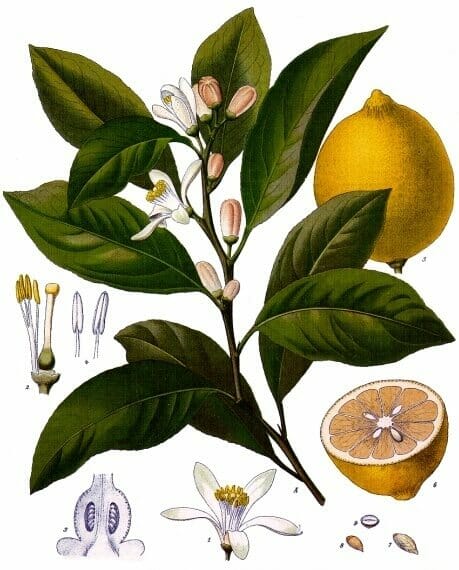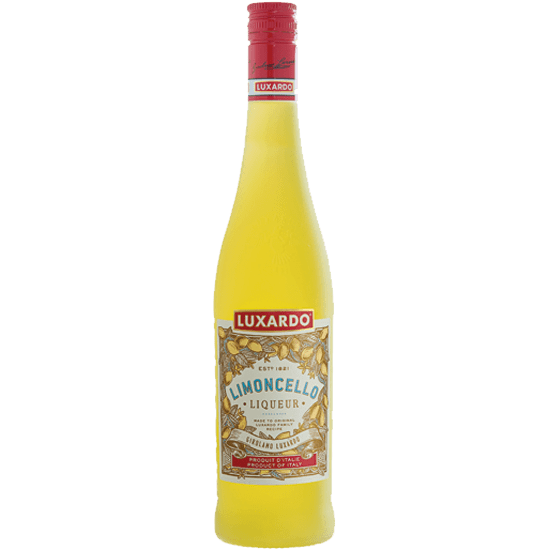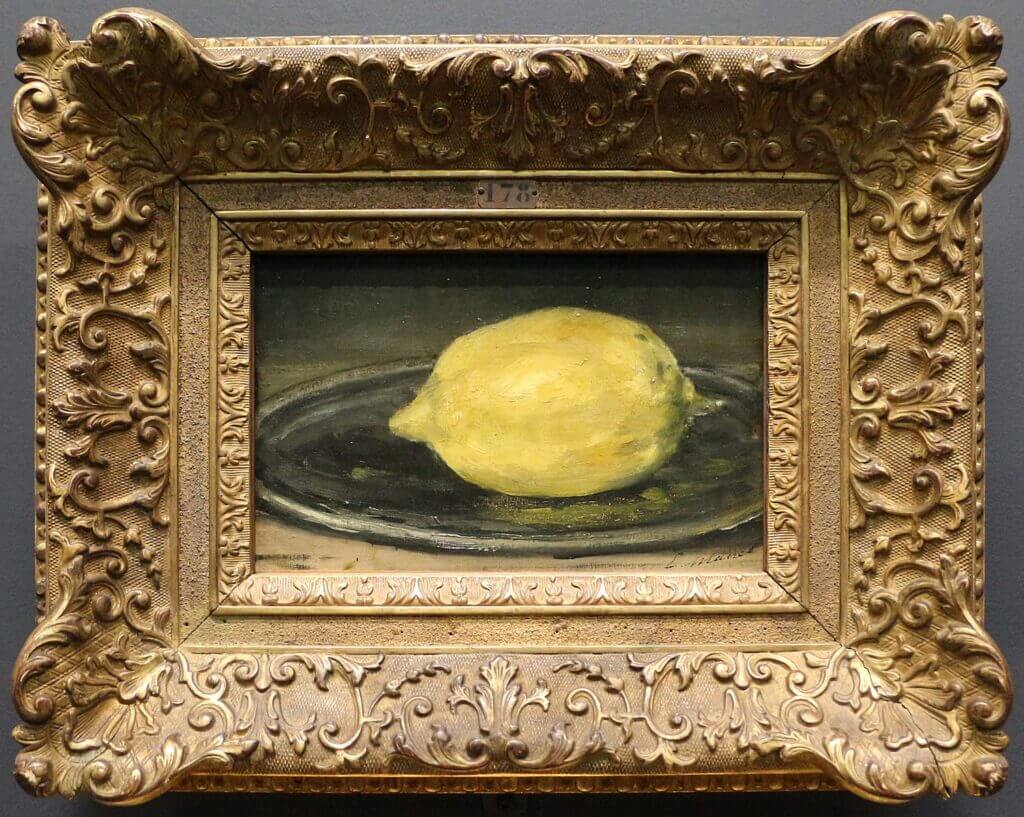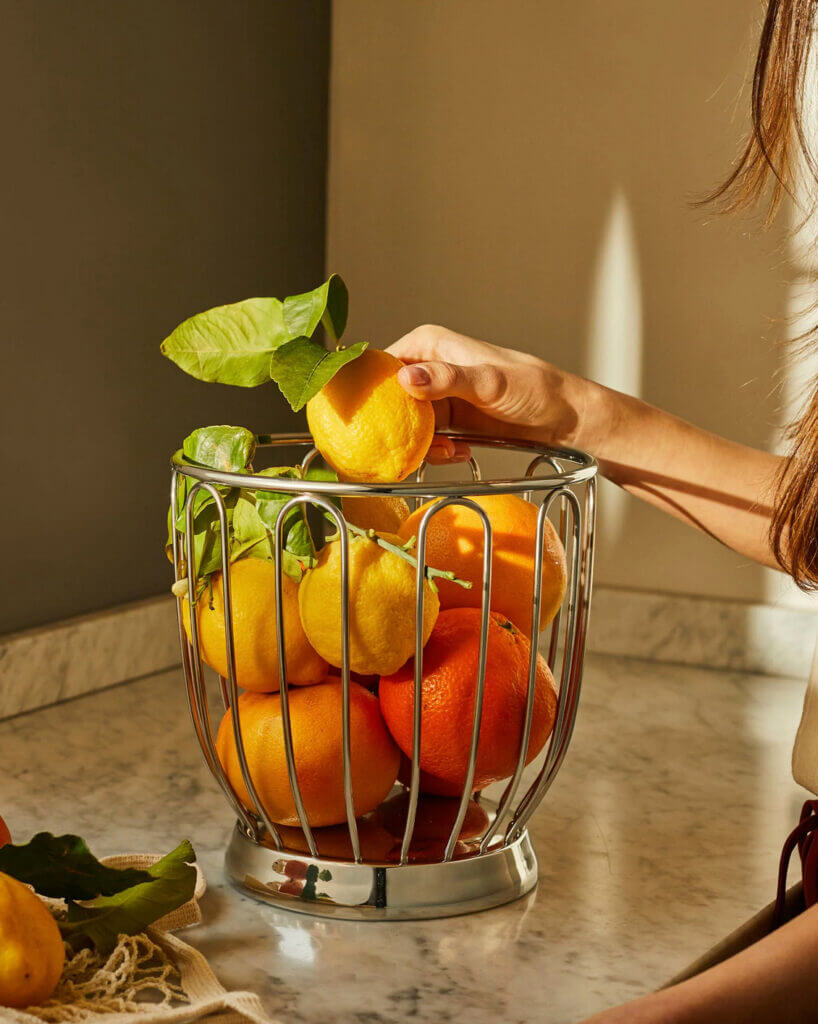The Lemon, that joyfully bright yellow fruit has been a part of our lives for ages. Revered for its fragrance, healing properties, sunny appearance, scent and culinary uses; lemons have a rich history and benefits many aspects of our lives.
While the origin of the lemon is unknown, it is thought that lemons were first grown in Assam (a region in northeast India) and are thought to have arrived in Europe near southern Italy in the second century AD, during the reign of Ancient Rome. Modern hypotheses place the arrival of the lemon to the Mediterranean region at around 100 AD, however the evidence for this is ambiguous. They were planted in orchards in Moorish Spain around the year 400.
Genoa saw the earliest significant lemon cultivation in Europe at the middle of the 15th century. Later, in 1493, Christopher Columbus transported lemon seeds to Hispaniola, introducing the lemon to the Americas. Lemon seeds were transported throughout the New World thanks to Spanish conquest. It was primarily used as a decorative plant and for medicinal purposes. Growing numbers of lemon trees were planted in Florida and California in the 19th century.
A grapefruit is just a lemon that saw an opportunity and took advantage of it.
Lemons have so have permeated our lives and touch many aspects including culinary, interior design, health and wellness, fine art, and even reduced the spread of the plague in France.

Culinary Uses of the Lemon
There are a wide variety of ways to use lemons in the culinary arts, in sweet and savoury dishes. Many different dishes and beverages contain lemon juice, rind, or peel. There is lemon liqueur, lemon curd, and marmalade which are all made using the entire lemon.
Lemon rind and slices are used as garnishes on both food and beverages. Lemon zest, which is the fruit’s grated peel, is used to flavour rice, baked goods, puddings, and other foods which brightens the flavour and gives it depth and literal zest. The leaves are used to make tea and in the preparation of seafood and cooked meats.
The juice of the lemon has a variety of uses from adding flavour to preservation. In fish its acid neutralises amines by turning them into nonvolatile ammonium salts, and it is used in fish marinades. The acid partially hydrolyzes tough collagen strands in meat, tenderising them, softening its structure. Lemon juice is also used as a short-term preservative on some foods, like apples, bananas, and avocados, where its acid denatures the enzymes and prevents oxidation and browning after cutting.
Preserved Lemons: Lemons take on an extraordinary flavour when they are preserved. In Morocco, lemons are preserved in salt jars or barrels. With preserved lemons, the salt’s penetration softens and preserves the rind and peel, rendering them nearly indestructible. Preserved lemon is used in many different types of food. All four European cuisines—Greek, Italian, French, and Sicilian—use preserved lemons.
Freezing Lemons:�?Lemons have a tendancy to spoil seemingly just as you need them for a beverage. A wonderful way to keep lemons longer for use in drinks is to freeze them. Wash, slice lemons, and store in a freezer safe bag or container and keep them stored in the freezer for use anytime you need them.
It is probable that the lemon is the most valuable of all fruit for preserving health.
— Maud Grieve

Limoncello a Lovely Liqueur
Limoncello is a lemon liqueur that is primarily made in Southern Italy, particularly in the area of the Sorrentine Peninsula and the Amalfi Coast. It is typically served cold as a digestivo, or digestive, after dinner and is the second most popular liqueur in Italy. With a variety of recipes available online and in print, it is also a well-liked homemade liqueur. It makes a lovely gift. The zest of Femminello St. Teresa lemons, often referred to as Sorrento or Sfusato lemons, is traditionally used to make limoncello. The lemon zest used to make limoncello, renders it to have a slightly turbid look due to the presence of tiny essential oil droplets suspended in the beverage. Limoncello typically has a 30% alcohol content.
Origins: It’s unclear where exactly limoncello originated. Federazione Italiana Industriali Produttori Esportatori ed Importatori di Vini, Acquaviti, Liquori, Sciroppi, Aceti ed affini claims that the grandmother of Maria Antonia Farace, who is said to have resided in a modest guesthouse on Isola Azzurra, invented Limoncello at the start of the 20th century. Some say that it was either created in Sicily over 100 years ago or was first produced on the Amalfi coast, where a number of towns and islands stake claim to being its birthplace.
According to journalist Kristen Tillotson, it may have been created by monks or fishermen much earlier or by an Azzurra citrus grove worker around 1900.
Enjoyment and Serving
Serve it after dinner, as it is a digestive. Although it is also excellent as a cocktail and aperitivo. Store your limoncello bottle in the freezer as it is best served very cold, but do not serve it on ice, as it dilutes the beautifully balanced liqueur. Freezer storage gives it a wonderfully syrupy consistency. To enjoy it as its best, it is ideally served in very small glasses like cordial or tall shot glasses so you can appreciate the beautiful colour. A lovely use is for a simple elevated dessert, drizzle it over dishes of vanilla ice cream, garnished with a small sprig of mint leaves.
The etymology of the word lemon comes from Middle English lymon, from Old French lymon (“citrus”), from Arabic لَيْمُون (laymūn) or Ottoman Turkish ل?�مون (limon), ultimately from Persian ل?�مو (limu). Cognate with Sanskrit निम्बू (nimbū, “lime”). Doublet of lime.
Lemonade Originated in Paris
In Paris, lemonade was first served on August 20, 1630. Vendors offered it for sale from tanks strapped to their backs. It was made from a combination of sparkling water, lemon juice, and honey. Despite being well-liked throughout Europe, lemonade gained such a following in Paris that in 1676 the vendors created an organisation known as the Compagnie de Limonadiers. Limonadiers walked around Paris with their tanks selling lemonade. Piles of used lemon peels followed these limonadiers wherever they went. Rats are omnivorous creatures, so they probably enjoyed the newly popular lemon as much as the Parisians did. According to Tom Nealon’s book, Food Fights and Culture Wars, even the bubonic plague was purportedly repelled in Paris thanks to the extensive consumption of lemonade. He contends that while rats nibbled the peels dropped by the limonadiers, fleas carrying the plague, responsible for its spread, were eliminated killed off by the lemon. While other major French cities were stricken with another round of the plague in the late 1600s that killed hundreds of thousands, this major metropolis was spared.

Lemons in Fine Art
In paintings, lemons became a symbol of luxury and a sign of wealth, along with priceless things from all over the world, lemons began to appear in art as a symbol of luxury and riches. During the seventeenth century, Dutch artists created over a quarter-million still life and genre paintings, more than half of which depicted lemons, whole, halved, or peeled. Why were these fruits so frequently painted? They were neither easy to grow nor widely available in Northwestern Europe. They were neither the sweetest nor the most beautiful fruit. From lemon’s lure to lemon’s cure, the lemon twist in paintings provides us with a tool for understanding the desires of the society of its time.

Before this time, we see lemons represented in still life paintings in Italy and Spain, and later all over Europe. Lemons provided a contrast to darker objects, angular forms, and smooth textures, which helped to add balance to the paintings. They allowed the artist to demonstrate their abilities in drawing details and colour. Most importantly, they added a multi-sensory dimension to a painting: one could see their bright colour and almost smell their fresh scent; look at their shiny rinds and imagine their bittersweet flavour. However, the lemon, so prevalent in paintings, had not yet entered common people’s kitchens in the 17th century.

Lemon Essential Oil and its Benefits for Beauty, Health and Wellness
For at least a thousand years, lemons and lemon essential oil have been used in Ayurvedic medicine to treat a variety of illnesses due to its versatility and potent antioxidant properties. Lemon essential oil is scientifically known as Citrus limon, a flowering plant in the Rutaceae family. Lemon plants are grown in many countries around the world, despite the fact that they are native to Asia and are thought to have been brought to Europe around 200 A.D.
It is important to note, that essential oils are highly concentrated and potent. More is not better. And quality is vital. Not all essential oils are the same. Many are not medicinal, and are cut with other oils and strong chemicals. it is advised to avoid those sold through multi-level marketing programs. Instead, favour artisanal makers, and companies renowned for 100% essential oils, organig and non GMO; check the horticultural name for added assurance you are getting the genuine oil. “Biochemically active, essential oils contain sometimes hundreds of chemical constituents that contribute to their aromatic profile, as well as their physiological benefits,” explains Adora Winquist, renowned alchemist and co-author of Detox. Nourish. Activate: Plant & Vibrational Medicine for Energy, Mood & Love. Consult with Certified Aromatherapists for assistance and guidance to ensure that the oils in particular, lemon or otherwise, is suitable for your particular concerns and will not conflict with other medications or health issues. Bottle colour must be dark in order to protect the oil. Check the bottle and or the brand’s website to ensure third party testing is used in their process.
A Must Have Essential Oil
Out of all the essential oils available, Lemon essential oil is on the Top 10 must-have essentials because of its widespread use, with the likes of the ever versatile Lavender oil, renowned for its benefits to health, beauty and wellness.
Beauty: Well reputed for its ability to treat acne, oily and dry skin, and it is frequently used in serums for brightening and anti-aging. When using lemon as part of facial treatments, it increases sun sensitivity, so be sure to use sunscreen to protect your skin.
Health: Lemon essential oil is an excellent remedy for those suffering with asthma, sore throats, bronchitis, sinus infections, and practically all respiratory illnesses when diffused or breathed. A nebulising diffuser is the ideal delivery source for breathing in this oil. A wonderful option for boosting circulation and has been shown to gently calm gout, rheumatism, and arthritis due to its ability reduce inflammation.
Wellness: Lemon has powerful psychological effects that are said to be felt almost instantly. This essential oil, considered a ‘joyful’ scent, it is one of the strongest antidepressants, is wonderful when used in blends to address anxiety, anger, confusion, and general feelings of being “rundown.” It is a mild but powerful mental stimulant that is frequently used to improve concentration and memory. Lemon can be added to sleep blends, perfectly paired with Lavender, to help reduce the intensity and frequency of nightmares.
Safe Use of Essential Oils
According to Robert Tisserand, one of the world’s leading experts in aromatherapy with over 40 years of experience and founder of the Tisserand Institute:
The essential oil in a bottle is 50-100 times more concentrated than in the plant, and safety issues apply to essential oils that may not apply to the whole plant or herbal extract. The rise in popularity of essential oils together with, very often, insufficient information on safety precautions in using them, coincides with an increased prevalence of adverse reactions, and it is likely that these are linked. Do not ingest essential oils unless advised to do so by a practitioner who is qualified/licensed to prescribe essential oils in this way. If you are diffusing essential oils, it makes more sense to do this intermittently than constantly, all day long. Ideally, diffuse essential oils for 30-60 minutes on, then 30-60 minutes off. Whenever you are using or diffusing essential oils, some air exchange (fresh air) is advisable.
Yellow is a very favorable vibration for mental or intellectual activity, as it promotes a clear state of mind. Yellow heightens your awareness and alleviates depression, sadness, or any kind of despondency. Yellow vibration foods are: pineapples, bananas, grapefruit, lemons and corn.
Lemon in Fragrance
A popular scent in fragrance, lemon is typically used as a top note. Bright, fresh, it pairs beautifully with lavender, yarrow, jasmine, geranium, ylang ylang, geranium, or rose.
Here are but a few of the many lovely luxury fragrances that feature the citrus fruit:
- Diptyque Oyédo Eau De Toilette: This fragrance opens as a juicy, fruity orange mingling with a juicy lemon.
- Maison Francis Kurkdjian Aqua Vitae: A citrusy, zesty but also green, sweet with slightly sulphurous facets. Sparkling and joyful top note enhances a Cologne and energizes this ambery perfume.
- Tom Ford Costa Azzurra: The scent of sea air, fresh aromatic notes, evergreens, and citrus sets the scene and mingles with deeper woody scents — a crisp medley of cypress, oaks, and aromatics.

Lemons on Display in Home Decor and Feng Shui
Their bright colour and friendly shape are a lovely accent in home decor. An array of lemons displayed in a bowl, silver urn, basket or other favoured vessel that suits your decor brings a burst of colour to a neutral palate or any kitchen space or home bar. Ideally use fresh if you’re going to be using them up before they spoil. Whole, fresh lemons can be kept for up to a week at room temperature. Lemons can also be frozen for three to four months or kept in the refrigerator for 4-6 weeks. There are also lovely faux decorative lemons that will always hold their shape and colour.
In Feng Shui, if this is your preferred manner of rules to follow in your decorating techniques, citrus fruits like lemons and tangerines are frequently employed in Feng Shui practises since it is thought that they bring good fortune. It is often advised to have 9 lemons in your kitchen or living room for prosperity.



